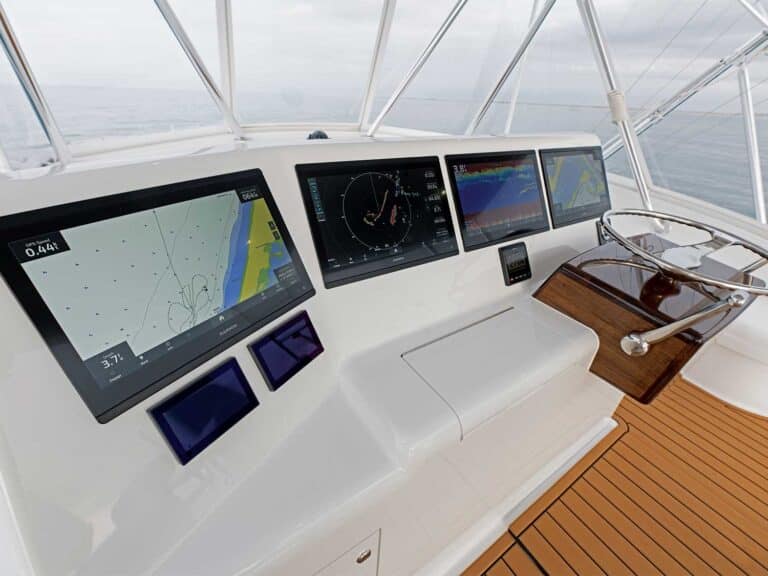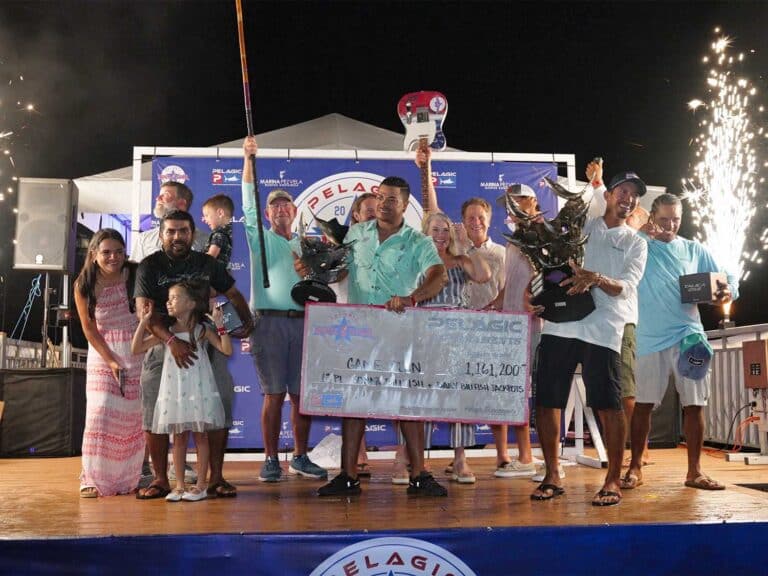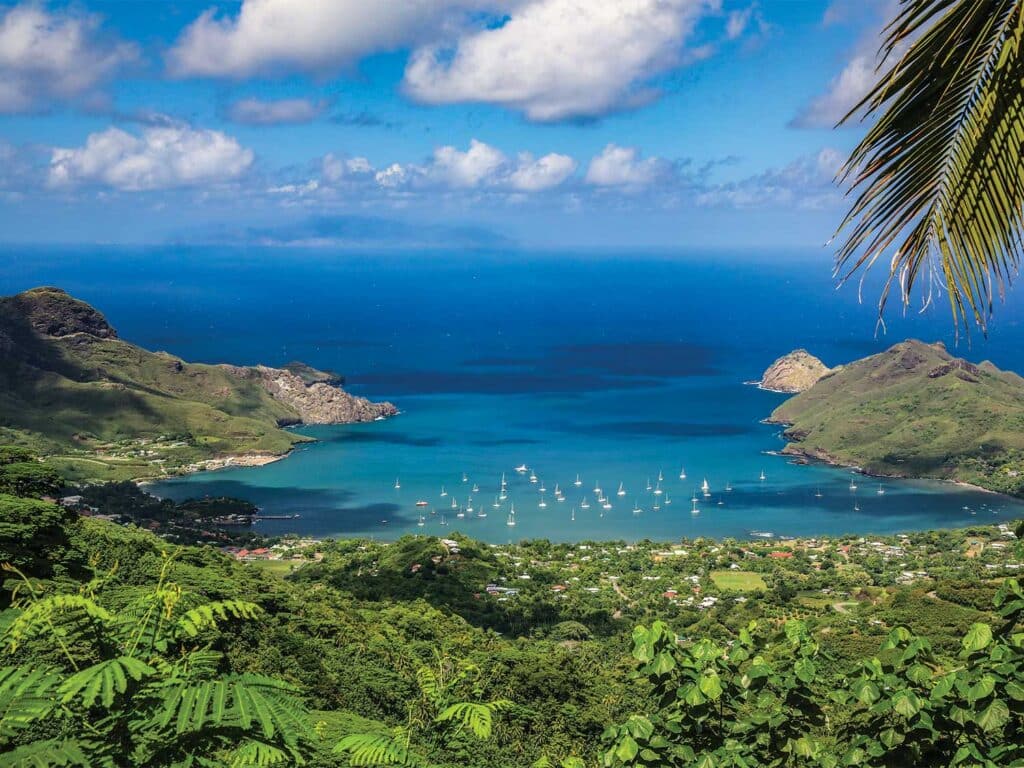
Special delivery: Sign up for the free Marlin email newsletter. Subscribe to Marlin magazine and get a year of highly collectible, keepsake editions – plus access to the digital edition and archives.
The world of secret blue marlin fishing spots gets smaller each year. I recall the rush over the years to fish Madeira, then Cape Verde, then Guiana, and then the Azores. Now it’s St. Helena and Ascension. Each destination seems to be a little more remote than the previous, adding even more mystique to the equation. While each of these hotspots surely deserves to be considered a bucket list location, they have one thing in common: They are all in the Atlantic.
Having spent the past 40 years working, fishing, diving, filming and exploring the Pacific Ocean, it is here that truly the most remote island groups and virgin blue marlin waters in the world still exist. The majority are located in French Polynesia, such as the Tuamotus, the Australs, the Gambiers and the most remote archipelago of the entire Pacific, the Marquesas Islands.
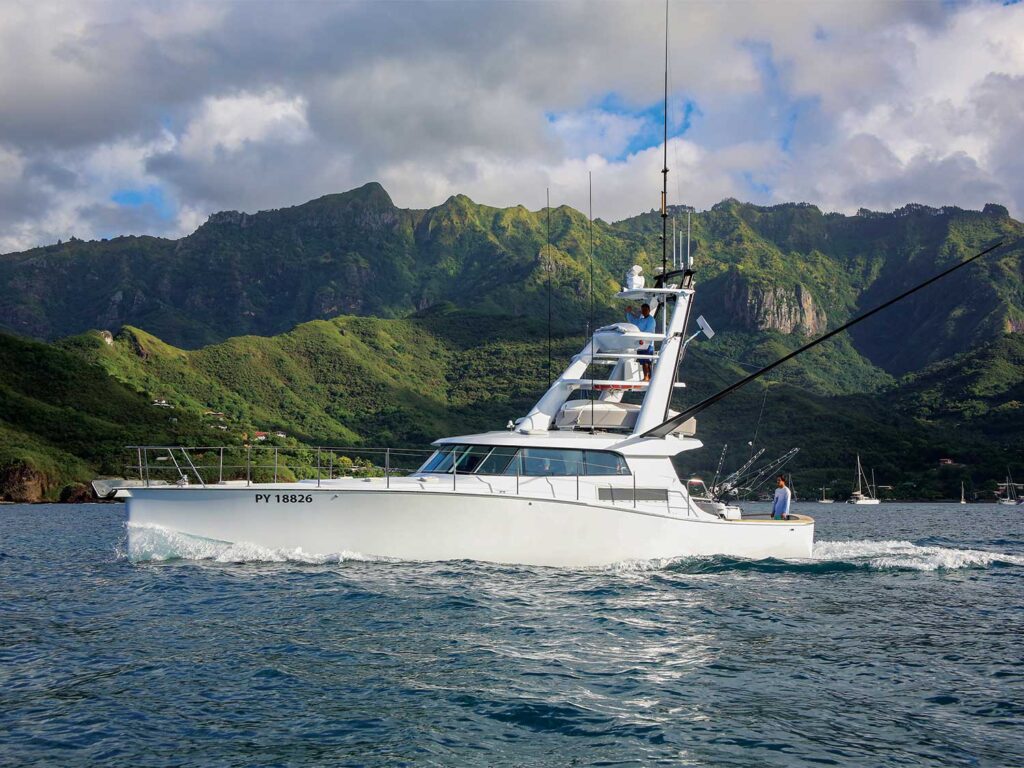
Chasing a Dream
I made a few dozen trips as a fisheries biologist on commercial tuna super seiners in the ’80s and ’90s, and on a few of these voyages got close to the Marquesas Islands. I mentally noted the astronomical concentrations of small tuna amassed in huge schools seen from our helicopter recon flights. Marlin fishermen know that where there are small tuna, blue marlin congregate. Should this occur in spawning areas, the fish can be big.
I yearned to return to these mystic islands to see for myself if my presumptions of world-class blue marlin fishing held true. Over the past ten years, I got close, working on several Tahitian sport-fishing projects with the New Zealand-based sport-fishing charter operation Ultimate Lady, traveling to and fishing the Tuamotus and the Austral Island groups.
While fishing with that top-notch crew, including Capt. Tom Francis and the boat’s owner, Fred Lewis, longtime Tahitian angler Daniel Sui shared some critical details about where we could find the big blues in French Polynesia. He pointed to the Marquesas Islands on an oceanographic chart and said, “Go there. That is where the big girls play.”
Sui went on to say that the average blue marlin caught over his 20 years fishing the Marquesas runs about 400 pounds but that fish over 700 pounds were commonly found in concentrations not seen throughout the rest of French Polynesia. Earlier this year, Lewis and Francis invited me to see if we could find the trophy blue marlin fishery that Sui had been so articulate in telling us about all those years ago. It took ten years and many daydreams, but I finally got my shot at sampling this wondrous location.
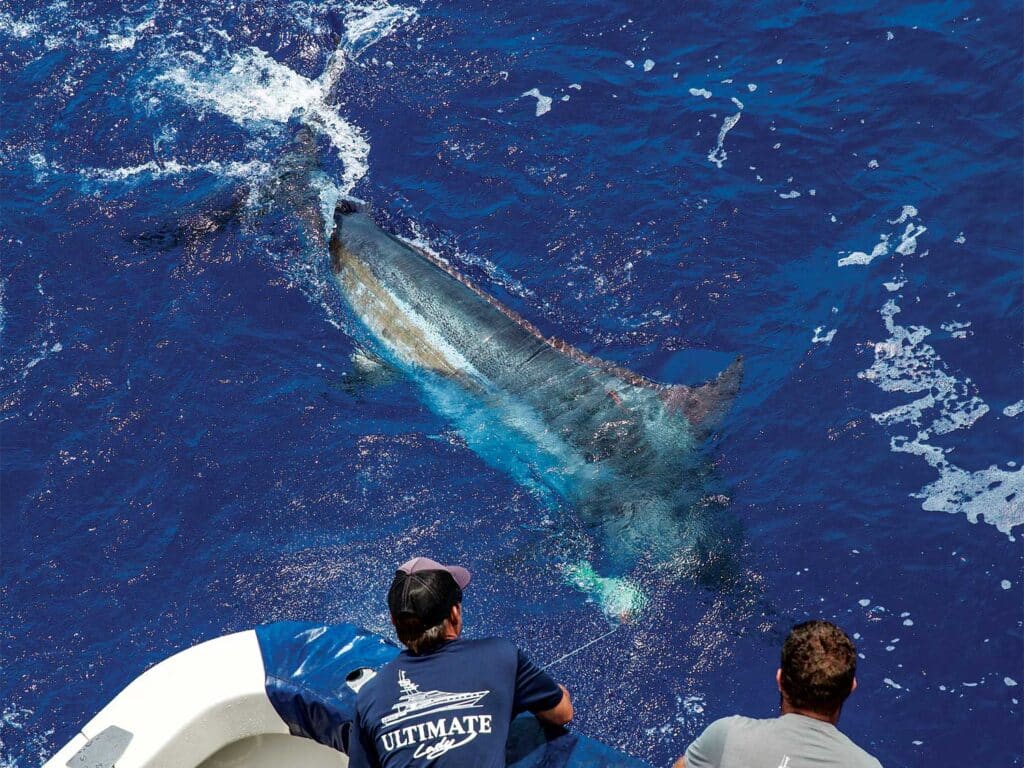
Remote in the Pacific
As mentioned, the Marquesas Islands are extremely remote, more so than even St. Helena and Ascension, which are located in the middle of the Atlantic some 1,500 miles from Africa and 2,500 miles from Brazil. The flight from London is 4,600 miles. In comparison, the Marquesas are 4,000 miles west of Ecuador, 3,400 miles east of New Zealand, 2,400 miles south of Hawaii, and 865 miles northeast of Tahiti. While it may seem like the jump from Tahiti to the Marquesas is short, keep in mind that it is already a 5,000-mile flight from Los Angeles to Papeete, Tahiti, and you’re still not even at your final destination yet. But after a few Air Tahiti flights and a layover, you make it to Nuku Hiva, the largest of the Marquesas Islands, and take the scenic winding route to the picturesque village of Taiohae.
A volcanic archipelago of 12 major islands—11 with considerable elevation and one that is an atoll—makes up the Marquesas. Five of the islands are located in a northerly group, while five others form a southerly group. The last two are known as the outer islands.
Throughout French Polynesia, the island groups are all very similar. Postcardlike, white, sandy, coral atolls, which gleam for miles as you approach by air, encircle volcanic crests of varying heights. That is not so in the Marquesas. After a three-hour flight on a dual turbo prop plane from Papeete, the deep blue ocean becomes remarkably broken by a series of statuesque green islands that appear as defiant sentries against Mother Nature, as if telling her not to mess with them. The geological features in the Marquesas look more like castles than rocky ridges. And most distinguishable, no coral atolls are present, just steep volcanic escarpments jetting majestically from the sea.
Between the islands are several areas of fish aggregating structure in the form of banks, pinnacles and steep drop-offs. The intense upwelling of nutrients created by strong trade winds blowing across the central Pacific and the strong westerly flow of the South Equatorial Current creates an incredible biomass of algae, zooplankton and forage fish within the water column. Painted with this diverse biological soup, the waters surrounding the Marquesas Islands are extremely productive and unique.
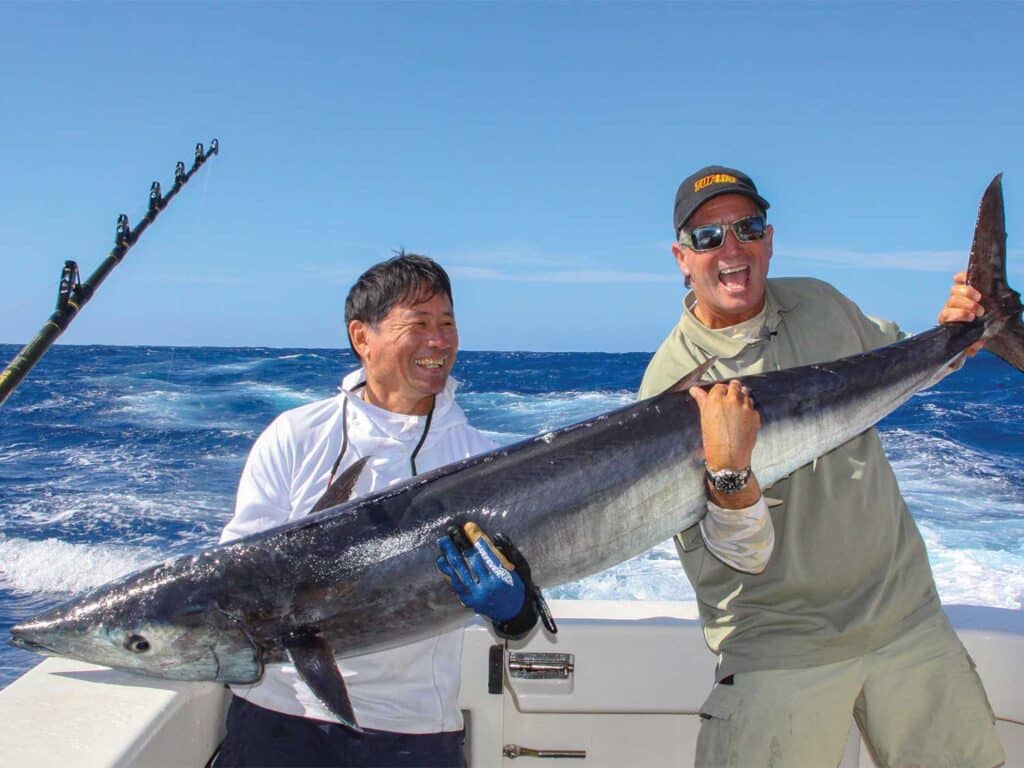
Fishing the Marquesas
Fishermen and scientists have discovered a very low incidence of black marlin, striped marlin and shortbill spearfish throughout the Tahitian island groups. Sailfish are present but not common by any metric. However, blue marlin are seen with regularity.
As for the Marquesas, the best times to fish blue marlin tend to be January through May, with peak periods during February, March and April. The tuna concentrations are present year-round, but it’s thought that large blue marlin migrate through the area during periods when the population of small tuna peaks. The blue marlin fishery in the Marquesas can be like that of Madeira, where concentrations of larger females are prevalent at certain times.
The fishing pressure for marlin here is basically nonexistent. The Nuku Hiva/Taiohae harbor is full of sailboats, but the only two sport-fishers targeting marlin in this area are Lewis’ Ultimate Lady, a 93-foot LOMOcean custom catamaran sport-fisher, and Francis’ 49-foot LOMOcean custom sport-fisher Seawolf. And the proximity to the offshore bite is unparalleled. Lines go in the water the minute you clear the harbor.
The majority of their effort occurs on day trips off Nuku Hiva, but when booked for multiday charters, the effort is often extended to other northern islands like Eiao, which is surrounded by lots of oceanic seamount features and holds a lot of marlin. Francis has not fished much around the island Ua Pou, but local commercial fishermen frequently speak about the quantity of marlin they catch there when fishing for other species.
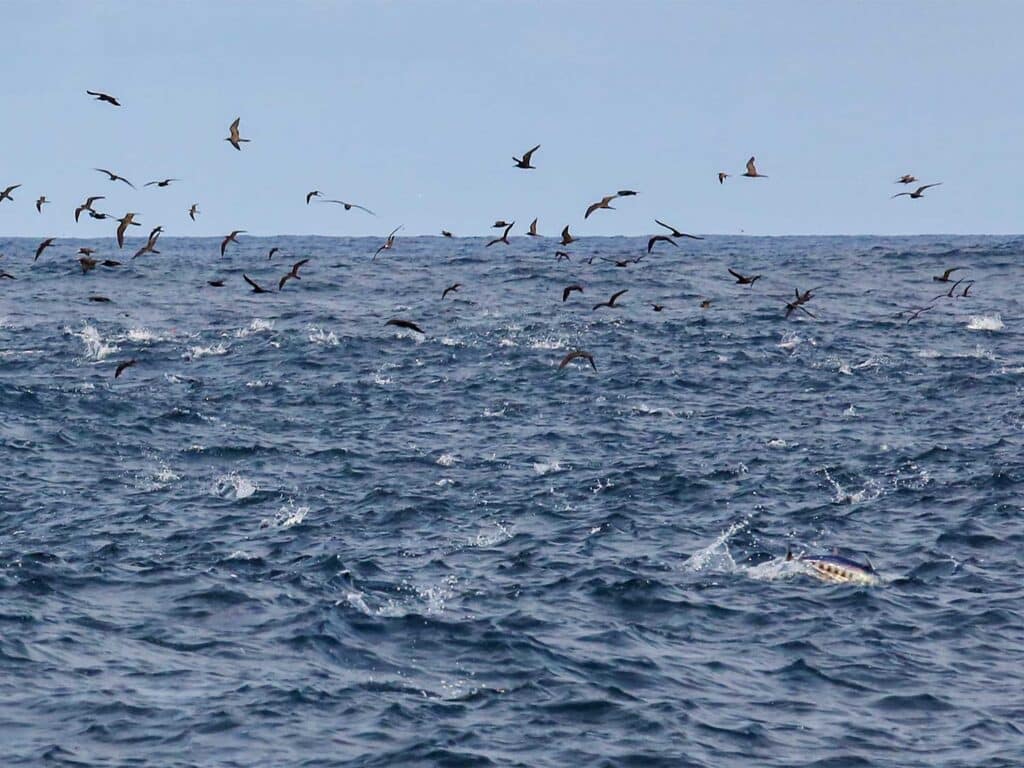
In the southern group of islands that Lewis, Francis and Sui have fished is Hiva Oa, where large marlin have often been spotted on the surface hunting tuna. A commercial fisherman fished there in March a few years ago and observed what he thought was a large school of tuna busting the surface. As he approached, he realized he’d stumbled on a large school of blue marlin making the ruckus. While not for certain, this could have been a rare blue marlin breeding aggregation, supporting scientists’ predictions that the Marquesas are breeding grounds.
During my visit, we targeted blue marlin on Ultimate Lady and Seawolf equally and used a bevy of Black Bart, Joe Yee, Marlin Magic, Mold Craft and Zuker baits all rigged with 500-to-650-pound leaders and super strong 10/0 forged Fudo hooks to replace hooks that a few fish in the area bent and broke. Between the two boats, we released three blue marlin, raised three others, and caught a sailfish. We also boated some nice wahoo, yellowfin tuna and giant trevally.
Fishing was slower than expected in the Marquesas when I was there, likely due to El Niño conditions. Sea temperature regimes in the Pacific shift, often dramatically, between El Niño and La Niña periods. Waters are warmer in the equatorial Pacific during El Niño years and cooler during La Niña. When I was there in June, the conditions off the Marquesas Islands were typical of those found in El Niño cycles and the water was several degrees warmer. Farther southwest toward Tahiti, a good concentration of large 700-to-1,000-pound blues was caught in water temperatures that are typical in the Marquesas at this time in a normal year.
That said, a week after my return stateside, a massive fish was hooked on Seawolf. Even with the precautions for heavy rigging and strong hooks, the huge fish straightened the hook enough for it to pull free. A month or so later, as I drafted this article, the crew aboard Seawolf caught and released a 700-pound blue marlin.
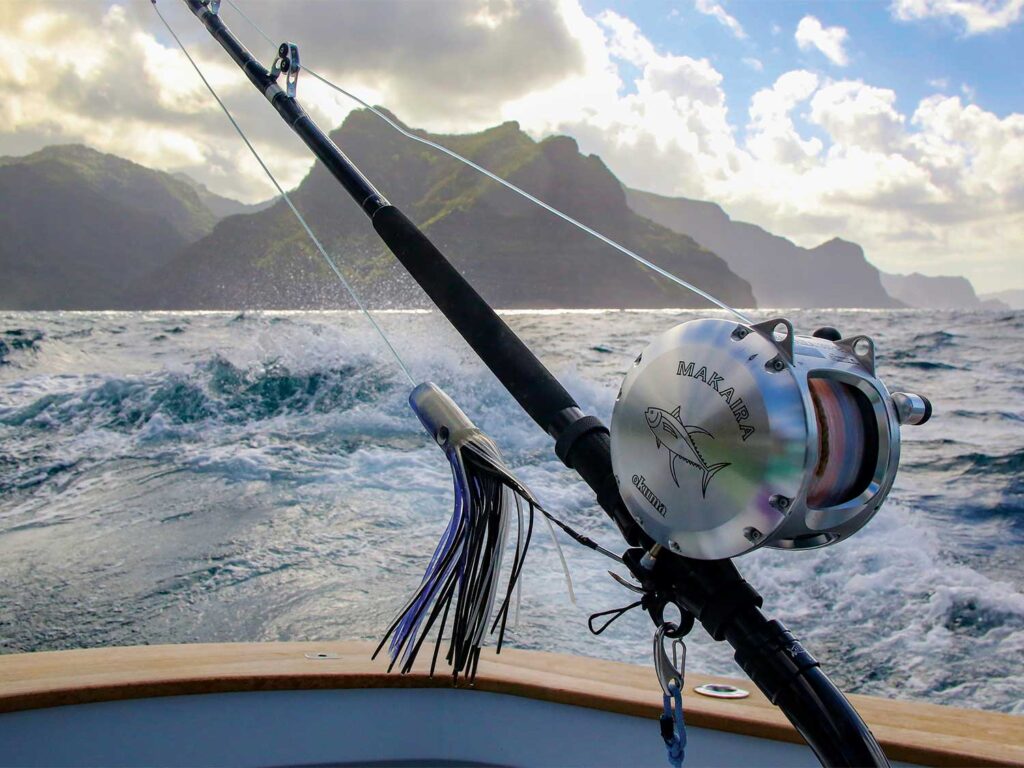
Mysteries in the Marquesas
With the advent of pop-up satellite archival tags, most anglers are aware of the international tagging efforts over the past few decades to deploy them on blue marlin the world over. What we have been finding is a complete rewrite of the book previously written from old-fashioned spaghetti tagging programs. Sure, these conventional tags provided point A to point B horizontal migration data over time, but when a pop-up satellite tag performs as designed, the amount of movement data we are obtaining is changing our entire understanding of life-history movements of blue marlin. From feeding areas to breeding areas, when enough tags have been administered in a region, a trend can begin to develop. When you look at the wide area encompassing French Polynesia and consider the small number of pop-up tags that have been placed in blue marlin in the region, there’s just not enough data to piece together those trends.
After returning from the Marquesas, I’ve had conversations with one of the top tagging scientists in the world, Barbara Block of Stanford University. Block and her team are extremely interested in more tagging support from private and government agencies to get more data to unlock the mysteries of blue marlin biology in the region. To date she indicated that tagging data demonstrates blue marlin have been seen coming to French Polynesia primarily from Kona, Hawaii; and Australia. Why they come is not yet known, but most speculate blue marlin visit the area to feed on those abundant shoals of tuna I spotted from the air all those years ago. Blue marlin may also be in the region to spawn, given the optimal conditions and presence of small billfish in the region. Tagging data also indicates that blue marlin from Kona can travel to French Polynesia in less than 150 days.
Read Next: On the Hunt for Giant Blue Marlin in Madeira.
The Marquesas Islands have much more life in the pelagic layer than anywhere else I have fished in Tahiti. In just the short time I fished with Francis, we saw and heard of a few blue marlin caught in the 30-to-50-pound range! Those fish were most likely born in these waters and over time will roam elsewhere. Further connections may exist in the eastern Pacific. Block mentioned a blue marlin tagged in Costa Rica as part of the IGFA Great Marlin Race made a westward migration, coming close to the eastern edge of French Polynesia.
With future tagging efforts in the Eastern Tropical Pacific, as well as Kona, and tags set to one-year deployments or longer, we hope to answer questions regarding when and why blue marlin come to French Polynesia, including the Marquesas. By using boat operations like Seawolf and Ultimate Lady to help with international tagging programs like the IGFA Great Marlin Race, these mysteries could get unraveled. Until then, one of the world’s most remote billfish destinations holds on to her secrets.
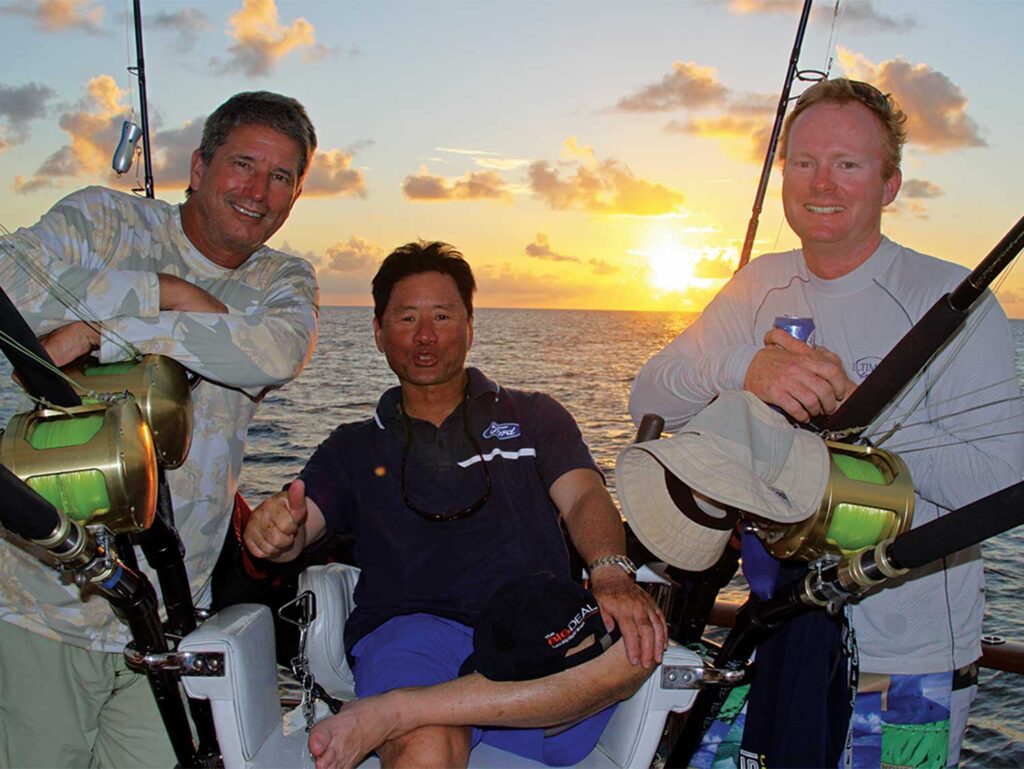
Fishing Options for the Marquesas
You have two options to fish in the Marquesas. First, you can enjoy a land-based option where you stay in one of a few hotels near the edge of the bay and fish daily trips with Francis aboard Seawolf out of Nuku Hiva. Second, you can book a multiday, multi-island fishing excursion to the outer islands of the north and south. Trips can be tailored to your taste of fishing, which could include inshore species and tuna as well. Hotel accommodations can be made at www.seawolfexpeditions.com.
You would have to search the world over to find two more uniquely engineered fishing platforms than Ultimate Lady and Seawolf. Both are of Kiwi heritage, and the innovations, designs and quality of construction clearly show how well the New Zealand LOMOcean boatyard can build a boat. They differ greatly in layout; Ultimate Lady is a catamaran with a third middle hull in bigger seas, and Seawolf is a plum-bowed monohull with lines and features that are well suited for the fishing world. Both boats are extremely economical. Ultimate Lady burns only 8 gph while trolling nine knots. Sea Wolf can fish all day on just 25 gallons.
Ultimate Lady is massively roomy with three decks, including a spacious crows-nest area that can accommodate four people with ease. Up top, a side-scanning sonar puts this beast on marlin wherever present, and down below, its catamaran-style build leaves a very clean stern wake. Both side hulls have extra-large marlin doors aft. The fighting chair swivels on a long-extended mount where the angler can fish both port and starboard angles with ease.
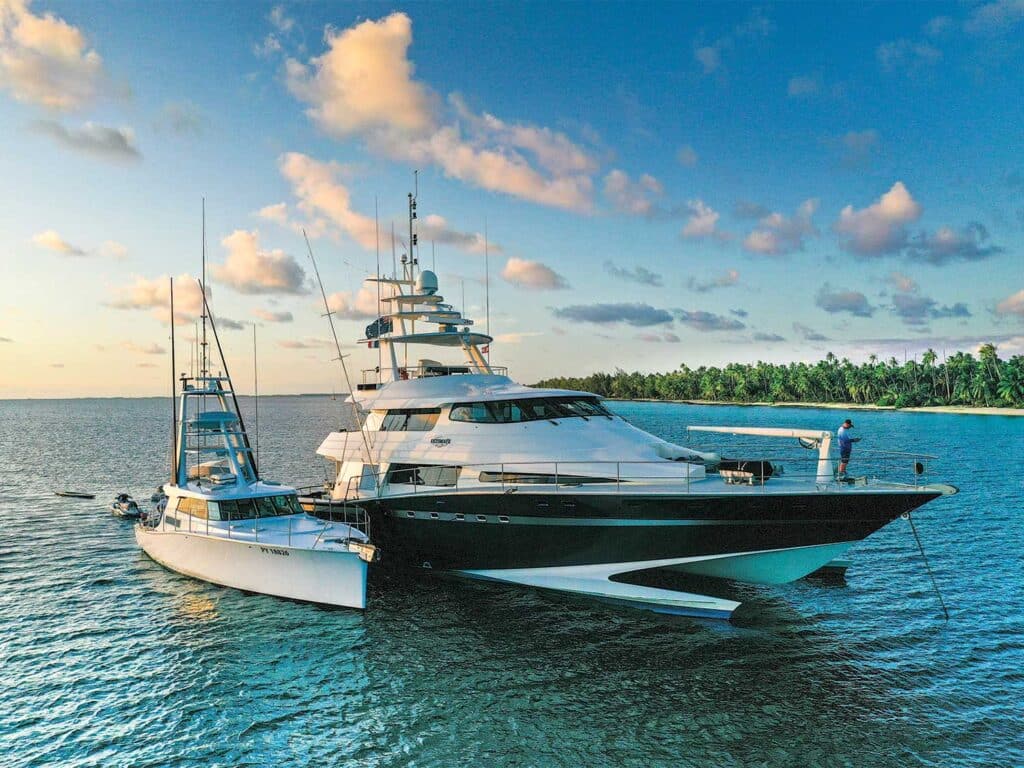
Seawolf features some amazing cutting-edge technology. The single screw terminates into a four-bladed, variable-pitch prop built in the Netherlands. The stern configuration has rounded corners, and the bottom edge of the stern is angled for quick back-down performance that lifts the hull as opposed to pulling it under. The bunks are wide and roomy, and the salon has 360-degree visibility. The outriggers are custom-designed, chambered carbon-fiber masterpieces. Frankly, there is nothing quite like them in the industry. The entire tower is fiberglass and carbon fiber molded and constructed.
Not all anglers who have an interest in chartering an operation like Seawolf will be hell-bent on marlin only. In fact, many anglers from around the world are just as excited about catching the large yellowfin, bigeye and dogtooth tuna that are seemingly everywhere structure is to be found in the Marquesas. Tuna from 100 to 200 pounds are common, and Sui has heard from some local artisanal longline fishermen that they feel, with the large size of bigeye tuna and the frequency with which they are found with eggs in the south islands, this area could be a breeding ground for the species.
Wahoo and dorado are commonly caught in the marlin efforts offshore, and to those interested in inshore popping or casting crank baits, lots of sizable giant trevally and bluefin trevally are present, ready and accommodating. If you plan to fish the GTs, bring stout tackle and an IGFA scale. Just saying, they can be huge.





